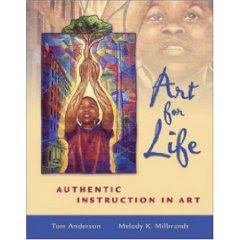The Teacher's Role
-Guiding students to create and appreciate
-Create a positive climate for inquiry, creativity, and individuality
-This requires purposeful, consistent, and time-consuming effort
-Try all projects/techniques first
-Learn about pop culture and use as motivation
-Guide students to consider aesthetic choices
-Use audiovisual aids as much as possible
- original art
- reproductions - include artist's names
- films (i.e. Art Babble)
- photographs
- slides
- video recordings
- magazine articles
- colorfully illustrated books (have an art book corner)
- show examples of student work
- kinetic displays
Have a Positive Personality, Build Rapport, and Respect
-Be positive, cheerful and outgoing
-Be patient, calm, resolute, and firm
-Listen to children's descriptions of their experiences, real and imaginary, with sympathetic interest
-Avoid a detached, keep-your-distance approach
-Commitment, concern, and excitement for project must be evident in actions, words, and facial expressions
-Develop empathetic rapport
-Respond intelligently, sympathetically, and purposefully to children's creative efforts
-Evaluate students' work seriously and objectively
-Take students seriously as artists
Get Off to a Good Start
-Begin with a serious, organized approach
-Make classroom orderly, yet inviting, visually stimulating, but not chaotic
- attractive bulletin-board exhibits
- found object displays
- plants
- art-book displays
- hobby collections
- antiques
- original art works
- have non-breakable things kids can touch
-Teach nonverbally
- use written and display materials
- use whiteboard to outline specific project objectives and motivational presentations
- post evaluative criteria in the form of questions
- perfect "the look"
- Establish procedures for everything
- Review procedures often
- Stay consistent
- Include students
- Supply adequate materials for the project at hand
- (You are NOT the maid!)
- Greet students at the door
- Start with a smile
- Calm students as they enter
- Have all eyes before speaking
- Don't start class the same way everyday
- 3-5 minutes
- bring students back with a pointed question, reprimand, or a pause with a meaningful look
- distribute materials after discussions
- first 3 minutes is crucial
- give specific tasks to hesitant students
- look for examples of creative uniqueness
- model, instruct, reinforce, question, and explain strategies for thinking in new ways
- show student examples, but don't single out one student or constantly interrupt a working class
- let projects stretch out over multiple classes
- continue to make students aware of project objectives
- create rubric with students
- keep students involved-make assignments personally meaningful
- post process and evaluative criteria on the board
- encourage students to go further
- combine praise with suggestions
- use in-progress work as examples of compositional requirements and variations in expression
- write brief constructive comments to older students
- plan procedures in advance
- use time after clean-up for evaluation or summing up
Manage Class by Teacher's Presence
-Be aware of what is going on in room and move strategically at critical times (never turn back to class)
-Move among students during studio activity
-Make clear that unruly behavior will not be tolerated
-Be serious
-Discipline and Redirect
- admonish student and tell them that infraction will be discussed after class
- use redirection and positive reinforcement to calm a talking class (i.e. hold up a student's work, emphasize an aspect of the project that needs amplification)






No comments:
Post a Comment